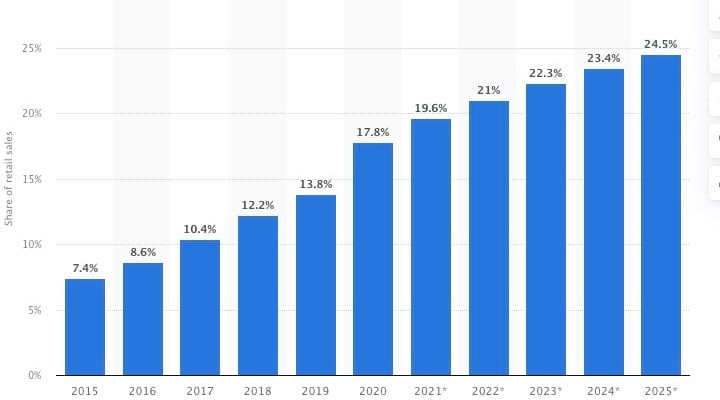An All-in-One Guide to a Successful Ecommerce A/B Testing

If you’re reading this, you’re likely running an ecommerce site. That’s great! Ecommerce is a great business model that has the potential to be very profitable.
In fact, according to Statista, in the next year, ecommerce retail purchases are expected to rise from 14.1% to 22%. So if you’re selling your products or services online, you’re in luck. There’s never been a better time to start an ecommerce business.
So why is it that you do not see the sales that you had hoped for? If you’re like many businesses, your conversion rate (the percentage of visitors to your site who buy something) is only about 1%, resulting in a lot of lost revenue. You may find that you’re facing a lot of online shopping cart abandonment, and you’re spending a lot of money on paid traffic but getting only average results.
Does this sound like your situation? Don’t fret. We’re here to help. It’s time to grab yourself a pen and paper (and a nice hot coffee) because we’re about to dive into the benefits of A/B testing, how to set up your first test (hands-on instructions included), and what tools are out there for you. Let’s get started!
What is A/B testing?
A/B testing is used to compare two versions of a product or page to see which one performs better. This is most commonly used in marketing but can also be applied to a range of other areas, from product design to social media management.
Pricing
A typical example is ecommerce pricing strategies. Ecommerce businesses have just one product page to sell their goods on, so it’s important to make the most of it. You only get one chance to make a good impression after all.
Imagine you’re managing a small business that sells sustainable clothing. You might opt for different pricing strategies that will vary the prices of each item, and this will be displayed on your product page. We’ll walk you through the process:
First, create two identical product pages with one simple variable (for example, the price). Next, send 100 people to each page and see which T-shirt sells better. Easy.
Design
A/B testing also lets you experiment with different design elements, such as your checkout page, product titles, and images, to see which one gets the best results. You can test buttons with different colours or messages against each other to find out which one is most effective at converting visitors into customers.
You may find that using different colours on your images may lead to more sales or that positioning the “Buy Button” at the top of your product page vs down below increases performance. You’ll never know until you test it!
Content
You can also experiment with your content to find out which style resonates best. Experiment with different types of posts, the frequency of posts, and how you present them. You can then analyze your results to see what works best so that you can generate more sales on your ecommerce site!
Your customers may love your how-to guides and product reviews, but they might find whitepapers and webinars less interesting. Study what interests your customers and adjust your content to match their preferences.
Benefits of A/B testing
There are five main benefits to A/B testing that you should be aware of:
1. Increases conversion rates
Businesses that have implemented an A/B testing strategy are likely to increase their conversion rates. There are multiple reasons for this, but the biggest is that A/B testing helps you to solve problems and find out what works best for your target market. Take a look at how A/B Testing drove more conversions at Union Bank.
2. Removes mystery from marketing
When something has worked great before, it doesn’t mean that it will work great forever. A/B testing helps you to remove the mystery from your marketing by finding out what works best for optimizing your website.
3. Focus on customer needs
As we’ve mentioned, there’s a big chance that your previous marketing strategies (that seemed to be working fine) were actually ineffective. With A/B testing, you can determine what works best for your target audience and focus on their needs. This will help you maximize your overall customer experience.
4. Drives data-based decisions
A/B testing helps you to cut down on bad decisions that are based purely on assumptions and instead use data-based decisions that are proven by numbers. This means that the changes you make will be solutions that actually solve problems and drive sales.
5. Helps with SEO and content marketing
A/B testing helps you to understand your target market, which in turn makes it possible for you to optimize your site content and SEO strategy accordingly. Remember that Google is all about user experience, so if users are finding what they’re looking for on your website, then this will reflect positively on your business.
How to set up your first A/B test
Now that we’ve covered the benefits of A/B testing, we’ll walk you through the process of setting up your first test. There are three steps involved:
1. Choose your topic
Make sure to choose a topic that will allow you to change one small detail about your page or product page for this initial test. You can then add in more variables later.
Let’s say you’re an ecommerce tech company that sells a state-of-the-art stock control system for restaurants. You could try changing the color or size of a button on your product page to see which one performs better.
2. Create a hypothesis
Your hypothesis is your educated guess on how you think the variables you plan to include in your test will impact conversions.
For example, if you were going to change the free video call button on your homepage and you thought this would increase the number of customers who clicked on the button, then your hypothesis would be “the number of customer’s who click on the free video call button will increase if it is larger.”
3. Create variation 1 and variation 2
You’ll need to create two slightly different versions of your product page. The only difference between these should be one variable that you plan to test. For example, if you wanted to test the colour and size of a button, then one version would have a small red button, and the other version would have a big blue button.
4. Set up your test
Now comes the fun part: setting up your A/B software testing! There are several tools available that will help you with this, such as Taplytics. The correct choice of tool depends upon the size of your business and the number of tests you perform.
If you’re a large corporation selling a huge range of products, like phones that make an HD call, laptops, and smartwatches, then you’d use a different tool than a small crafts boutique that sells personalized greeting cards. To set up your test, you’ll need to create variations and run your test concurrently.
5. Analyze the results
After your test has run for a few weeks and you can see how it performs, you need to do some analysis. This means reviewing the data and seeing which variation performed better. You’ll need to look at things like unique page views, bounce rate, conversions (the number of people who sign up), revenue per visitor, transactions per visitor, and goal completions.
6. Take action
Now, it’s time to take action! If the variation that performed better was your original version, then don’t make any changes (but keep A/B testing and see what improvements you could make).
If the new version that did well in the test had more unique page views than your original version, then try testing a larger button and see how that impacts your numbers.
If the new version had fewer unique page views than your original, then go back to the drawing board by continuing to experiment with different sizes and colours of buttons.
The bottom line
A/B testing is the best way to make data-driven decisions on your ecommerce site, which means you can de-risk your changes (such as updating copy, improving product images, or testing different designs) by analyzing their performance before they go live. The more tests you run, the more data you’ll have.
Soon enough, you won’t be asking yourself questions like “Should I improve my product images?” You’ll know precisely what to do with your site based on real numbers and statistics.
We hope this guide has given you a better understanding of how to successfully run an ecommerce A/B test in order to improve conversions and increase revenue.
Remember, this is just one of the brilliant marketing techniques for ecommerce businesses. Digital Signage in ecommerce, social media, and email marketing are also great ways to engage with your customers and boost sales.




